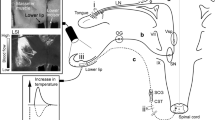Summary
The potency of parasympathetic vasomotor efferent nerves in controlling blood flow of the face and nose was indicated by the following features attributed to the maxillary artery and their vascular compartments in dogs. Electrical stimulation of the vidian nerve induced a frequency-dependent increase in maxillary flow, which was due to a significant decrease in resistance to flow in nutrient and shunt vessels. Pronounced increases in perfusion rates mainly occurred in evaporative tissues of the nose, in particular the naso-maxilloturbinates and alar fold during vidian nerve stimulation, while those, for example, of the skin remained unchanged. Adrenergic and subsequent cholinergic blockade left the response pattern of maxillary flow to vidian nerve stimulation basically unaffected. Both nutrient and shunt flows contributed to the parasympathetically induced increases in maxillary flow while responses were compartmentalized similar to that found in untreated animals. Apart from sympathetic vasoconstrictor inputs, these results show that cholinergic and non-cholinergic parasympathetic vasodilator inputs contribute to the adjustment of vasomotor tone in the maxillary vascular bed.
Similar content being viewed by others
References
Änggärd A (1973) The effects of parasympathetic nerve stimulation on the microcirculation and secretion in the nasal mucosa of the cat. Acta Otolaryngol (Stockh) 78:98–106
Blier Z (1930) Physiology of the sphenopalatine ganglion. Am J Physiol 93:398–406
Dorrong Y, Fontanji H, Pleschka K (1988) Vascular tone and reactivity to vasoactive intestinal peptide (VIP) in the internal maxillary vascular beds of the dog. Pflügers Arch 412 [Suppl 1]: 62, R37
Eccles R, Lee RL (1981) The influence of the hypothalamus on the sympathetic innervation of the nasal vasculature of the cat. Acta Otolaryngol (Stockh) 91:127–134
Eccles R, Wilson H (1974) The autonomic innervation of the nasal blood vessels of the cat. J Physiol (Lond) 238:549–560
Gadlage R, Behnke EE, Jackson RT (1975) Is the vidian nerve cholinergic? Arch Otolaryngol 101:422–425
Goodman LS, Gilman A (1985) The pharmacological basis of therapeutics, 7th edn. Macmillan, London
Hamilton CA, Reid IL, Sumner DJ (1983) Acute effects of phenoxybenzamine on adrenoceptor response in vivo and in vitro. Relation of in vivo pressor responses to the number of specific adrenoceptor binding sites. Cardiol Pharmacol 5: 868–873
Hashimoto M, Sommerlad U, Pleschka K (1987) Sympathetic control of blood flow to AVAs and capillaries in nasal and facial tissues supplied by the internal maxillary artery in dogs. Pflügers Arch 410:589–595
Ichimura K, Jackson RT (1984) Evidence of α2-adrenoceptors in the nasal blood vessels of the dog. Arch Otolaryngol 110: 647–651
Klaassen ABM, Megen YJB van, Kuipers W, Broek P van den (1988) Autonomic innervation of the nasal mucosa. ORL 50:32–41
Lacroix JS, Stjärne P, Änggärd A, Lundberg JM (1988) Sympathetic vascular control of the pig nasal mucosa. 2. Reserpine-resistant, non-adrenergic nervous responses in relation to neuropeptide Y and ATP. Acta Physiol Scand 133:183–197
Lundberg JM, Änggärd A, Emson P, Fahrenkrug J, Hökfelt T (1981) Vasoactive intestinal polypeptide and cholinergic mechanisms in cat nasal mucosa: studies on choline acetyltransferase and release of vasoactive intestinal polypeptide. Proc Natl Acad Sci USA 78:5255–5259
Lundblad L, Änggärd A, Saria A, Lundberg JM (1987) NPY and non-adrenergic sympathetic vascular control of the cat nasal mucosa. J Anton Nerv System 20:189–197
Lung MA, Wang JCC (1989) Autonomic nervous control of nasal vasculature and airflow resistance in the anesthetized dog. J Physiol (Lond) 419:121–139
Lung MA, Phipps RJ, Wang JCC, Widdicombe JG (1984) Control of nasal vasculature and airflow resistance in the dog. J Physiol (Lond) 349:535–551
Malcomson KG (1959) The vasomotor activities of the nasal mucous membrane. J Laryngol Otol 73:73–98
Malm L (1973) Stimulation of sympathetic nerve fibers to the nose of the cat. Acta Otolaryngol (Stockh) 75:519–526
Olsson P, Bende M (1986) Sympathetic neurogenic control of blood flow in human nasal mucosa. Acta Otolaryngol (Stockh) 102:482–487
Pleschka K (1984) Control of tongue blood flow in regulation of heat loss in mammals. Rev Physiol Biochem Pharmacol 100:76–120
Pleschka K, Sugahara M, Hashimoto M, Sommerlad U, Lürkens I, Ernst C (1987) Local circulatory control in thermal stress. In: Dejours P (ed) Comparative physiology of environmental adaptations, vol 2. Karger, Basel, pp 107–122
Pleschka K, Sommerlad U, Hashimoto M (1989) Microcirculatory adjustments in the nose and facial skin of the dog during hyperthermic panting. In: Mercer JB (ed) Thermal physiology. Excerpta Medica, Elsevier, Amsterdam, pp 581:586
Sachs L (1984) Applied statistics. Springer, Berlin Heidelberg New York
Thomson EM, Pleschka K (1980) Vasodilatory mechanisms in the tongue and nose of the dog under heat load. Pflügers Arch 151:523–542
Tschalussow MA (1913) Die Innervation der Gefäße der Nasenschleimhaut. Pflugers Arch 151:523–542
Uddman R, Alumets J, Densert O, Hakansson R, Sundler R (1978) Occurrence and distribution of VIP nerves in the nasal mucosa and tracheobronchial wall. Acta Otolaryngol (Stockh) 86:443–448
Uddman R, Malm L, Fahrenkrug J, Sundler F (1981) VIP increases in nasal blood during stimulation of the vidian nerve. Acta Otolaryngol (Stockh) 91:135–138
Author information
Authors and Affiliations
Additional information
Offprint requests to: K. Pleschka
Rights and permissions
About this article
Cite this article
Sugahara, M., Pleschka, K. Nutrient and shunt flow responses to vidian nerve stimulation in nasal and facial tissues of the dog. Eur Arch Otorhinolaryngol 249, 79–84 (1992). https://doi.org/10.1007/BF00186451
Received:
Accepted:
Issue Date:
DOI: https://doi.org/10.1007/BF00186451




